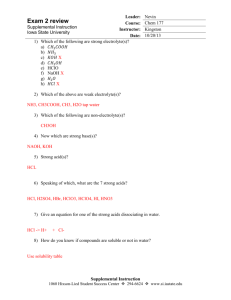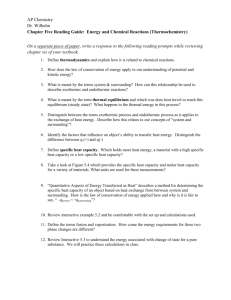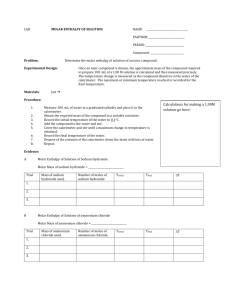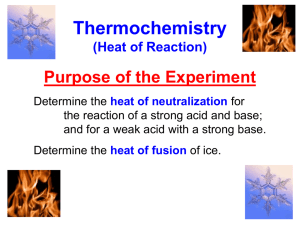5.1 b) CALORIMETRY
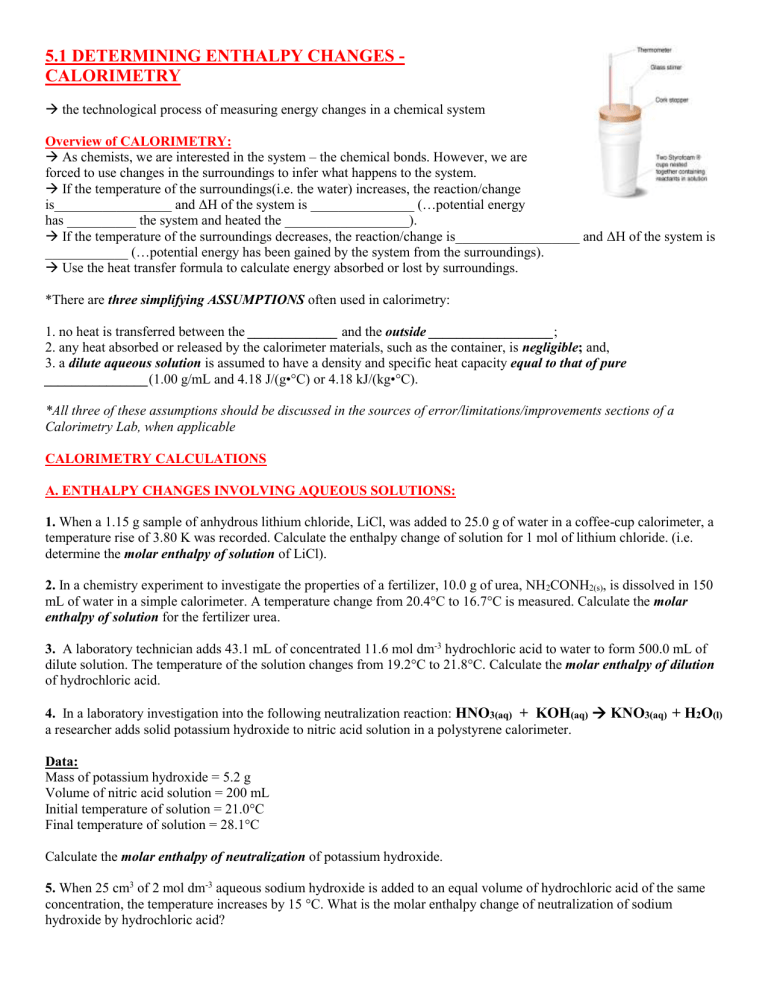
5.1 DETERMINING ENTHALPY CHANGES -
CALORIMETRY
the technological process of measuring energy changes in a chemical system
Overview of CALORIMETRY:
As chemists, we are interested in the system – the chemical bonds. However, we are forced to use changes in the surroundings to infer what happens to the system.
If the temperature of the surroundings(i.e. the water) increases, the reaction/change is_________________ and ΔH of the system is _______________ (…potential energy has __________ the system and heated the __________________).
If the temperature of the surroundings decreases, the reaction/change is__________________ and ΔH of the system is
____________ (…potential energy has been gained by the system from the surroundings).
Use the heat transfer formula to calculate energy absorbed or lost by surroundings.
*There are three simplifying ASSUMPTIONS often used in calorimetry:
1. no heat is transferred between the _____________ and the outside __________________ ;
2. any heat absorbed or released by the calorimeter materials, such as the container, is negligible; and,
3. a dilute aqueous solution is assumed to have a density and specific heat capacity equal to that of pure
_______________
(1.00 g/mL and 4.18 J/(g•°C) or 4.18 kJ/(kg•°C).
*All three of these assumptions should be discussed in the sources of error/limitations/improvements sections of a
Calorimetry Lab, when applicable
CALORIMETRY CALCULATIONS
A. ENTHALPY CHANGES INVOLVING AQUEOUS SOLUTIONS:
1.
When a 1.15 g sample of anhydrous lithium chloride, LiCl, was added to 25.0 g of water in a coffee-cup calorimeter, a temperature rise of 3.80 K was recorded. Calculate the enthalpy change of solution for 1 mol of lithium chloride. (i.e. determine the molar enthalpy of solution of LiCl).
2.
In a chemistry experiment to investigate the properties of a fertilizer, 10.0 g of urea, NH
2
CONH
2(s)
, is dissolved in 150 mL of water in a simple calorimeter. A temperature change from 20.4°C to 16.7°C is measured. Calculate the molar enthalpy of solution for the fertilizer urea.
3. A laboratory technician adds 43.1 mL of concentrated 11.6 mol dm -3 hydrochloric acid to water to form 500.0 mL of dilute solution. The temperature of the solution changes from 19.2°C to 21.8°C. Calculate the molar enthalpy of dilution of hydrochloric acid.
4.
In a laboratory investigation into the following neutralization reaction: HNO
3(aq)
+ KOH
(aq)
KNO
3(aq)
+ H
2
O
(l) a researcher adds solid potassium hydroxide to nitric acid solution in a polystyrene calorimeter.
Data:
Mass of potassium hydroxide = 5.2 g
Volume of nitric acid solution = 200 mL
Initial temperature of solution = 21.0°C
Final temperature of solution = 28.1°C
Calculate the molar enthalpy of neutralization of potassium hydroxide.
5. When 25 cm 3 of 2 mol dm -3 aqueous sodium hydroxide is added to an equal volume of hydrochloric acid of the same concentration, the temperature increases by 15 °C. What is the molar enthalpy change of neutralization of sodium hydroxide by hydrochloric acid?
B. MOLAR ENTHALPY CHANGE OF COMBUSTION, ∆H c
1.
A calorimeter is used to determine the enthalpy change involved in the combustion of eicosane (C
20
H
42
), a solid
hydrocarbon found in candle wax. Complete the Evaluation section of the investigation report.
Experimental Design:
A candle is place under a copper can containing water, and a sample of candle wax (eicosane) is burned such that the heat from the burning is transferred to the calorimeter.
Raw Data:
QUANTITY MEASUREMENT
Mass of water 200.0 g
Specific heat capacity of copper 0.685 Jg -1 K -1
Mass of copper can 50.0 g
Initial temperature of calorimeter 21.0 °C
Final temperature of calorimeter
76.0 °C
Initial mass of candle wax
Final mass of candle wax
8.567 g
7.357 g
EVALUATION: a) Calculate the molar enthalpy of combustion of eicosane. b) Was the reaction exothermic or endothermic? Explain. c) Write a thermochemical equation to represent the combustion of eicosane. d) If the accepted value for the molar enthalpy of combustion of eicosane is -1.33 x 10 4 kJ mol -1 , calculate the percent difference. Comment on the accuracy of the experimental result.
2.
A camping stove, burning butane, was used to heat 500 g of water from 20 °C to 100 °C. This process requires approximately 168 kJ of energy. a) If the container holding the water was made out of aluminum and it weighed 100 g, how much heat energy was required to heat the container (the specific heat capacity of aluminum is 875 J kg -1 K -1 )? b) What is the total energy required to hear the pot and water? c) When the water reached 100 °C (i.e. started to boil), the stove weighed 14.5 g less than it had initially. How many moles of butane (C4H10) were used to heat the aluminum container and water? d) Use these data to calculate the molar enthalpy of combustion of butane. e) The accepted value for the enthalpy of combustion of butane is 2874 kJ mol-1. Calculate a % difference and then explain why you think the difference is so high.
3.
Liquid ethanol, C
2
H
5
OH
(l)
, has been proposed as an alternative fuel. Determine the enthalpy of combustion per mole of ethanol using the experimental data in the following table.
Mass of ethanol 3.26 g
11.7 kJ/°C Heat capacity of calorimeter
Initial temperature of calorimeter
Final temperature of calorimeter
21.5 °C
29.4 °C
